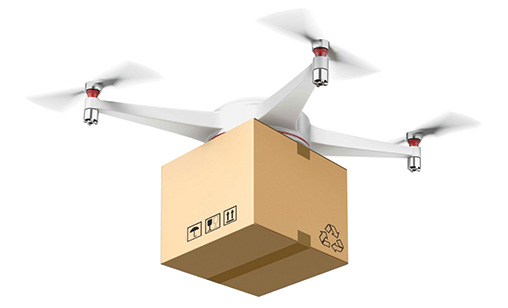Cargo Update
Drones the cargo carriers of the future
There is a silver lining to the increasing numbers of unmanned aerial vehicles flying the world’s skies, argues the International Air Transport Association (IATA).
February 1st 2018
Imagine a time when a Singapore Airlines (SIA) freighter lands at Changi airport with a valuable cargo payload. Read More » Rather than offloading the goods to trucks for delivery to customers, instead they are transferred to a purpose-built, pilotless drone owned by the airline and flown directly to waiting customers. The process is not only faster but cheaper than using road transport.
The International Air Transport Association’s (IATA) head of cargo transformation, Celine Hourcade, said such a concept is fast approaching reality – possibly within the next five years – and was waiting for airlines to grasp the opportunities drone technology offered to the industry.
 |
Using Unmanned Aerial Vehicles (UAV), or drones, for fast delivery of freight from customer to cargo terminal and from cargo terminal to customer made sense, she said.
Does she see airlines and their cargo divisions having their own drone operations? “Yes, I do,” said Hourcade. “It will be their decision individually to take it or not. It is a new type of aircraft they can integrate into their fleets. So, they could decide to go the last mile.
“They could also add bigger drones to serve new routes or thin routes that are too small to operate traditional aircraft or don’t require the same runway or the same infrastructure as bigger planes. It’s an opportunity for airlines to expand their reach.”
The use of drones is hardly new in aviation, but the notion that airlines could get into the business with the encouragement of their global representative association is a revelation. Hourcade pointed out companies trialing drones are everywhere. They include shippers and e-commerce vendors such as Walmart, Amazon and China’s Alibaba, integrators like DHL and UPS as well as postal operators in Singapore, Australia, France, Switzerland, Spain, Ukraine and Germany. The big aircraft manufacturers, Airbus and Boeing, are working on unmanned aircraft projects.
Small drones are merely the beginnings of this breakthrough technology. A U.S. company has announced plans for an amphibious pilotless aircraft, about the size of a Boeing 777, that could carry almost 100 kilogrammes of cargo.
Headquartered in Richmond, California, Natilus has raised $750,000 from venture capitalist, Tim Draper, to develop its product but needs additional investment to bring the project to fruition. Natilus chief executive, Aleksey Matyushev, said the drone would be powered by turbofan engines and standard jet fuel on missions at an altitude of approximately 20,000 feet, well below commercial aircraft altitudes but high enough to be fuel-efficient.
 |
| 'We believe the use of drones for the transport of goods brings unique opportunities for our member airlines. They offer opportunities for existing players and for new players. This is a not to be missed opportunity for our member airlines to capture new markets, open new routes, reduce costs, increase speed and increase revenues' |
| Celine Hourcade International Air Transport Association (IATA) head of cargo transformation |
Matyusheve said journeys across oceans would be approximately 50% cheaper than commercial air freight transport runs.
Commercial drone business development required standardized global operating standards, IATA said. An air traffic management system also needs to be developed to integrate drone operations into the existing global ATM structure.
“Our goal is to facilitate this new branch of aviation by writing standards to support safe, efficient, orderly, reliable and sustainable drone operations into the airspace system,” said IATA’s director of ATM infrastructure, Rob Eagles.
IATA is focused on three areas: Safety, ATM – UTM (Unmanned Aircraft System Traffic Management). The association has produced videos, including one in partnership with Airbus and UPS, to argue for relevant regulation for the sector.
“If UAS operate in existing airspace structure we need to ensure they do so safely,” Eagles said. “To do this, we need rules and regulations, especially for international operations. This work is on-going within ICAO.
“Additionally, new airspace areas need to be defined, in particular below 500 feet and above 60,000 feet.”
Eagles said IATA is actively engaged in the development of remote pilot training, licensing and medical requirements to ensure non-segregated airspace is not compromised.
Carrying cargo is not the only opportunity drones offer airlines, said Hourcade. Eighty per cent of aircraft inspections are conducted visually during planned maintenance checks or after unscheduled events such as lightning strikes.
“Every inspection requires qualified staff, using cherry-pickers, elevators and other heavy equipment, to locate and log defects on an aircraft. Typical inspections last six to ten hours and cost carriers $10,000 for every hour the aircraft is grounded,” she said.
“Automated drones could make the inspection 20 times faster, reduce aircraft downtime, enhance inspectors’ productivity and guarantee traceability.”
| Alibaba tests unmanned aerial vehicle package deliveries Last November, Alibaba used drones to deliver packages over water for the first time. Three unmanned aerial vehicles (UAVs) carried six boxes of passion fruit, at a weight of 12 kilograms, from Putian in China’s eastern Fujian Province to nearby Meizhou Island. Flying into a strong wind, the boxes took nine minutes to make the five kilometre crossing. The drones were jointly developed by Alibaba’s delivery arm, Cainiao Network, the company’s rural shopping platform, Rural Taobao, and a Mainland technology company. The drone delivery service cut the transportation time by half and reduced charges. |